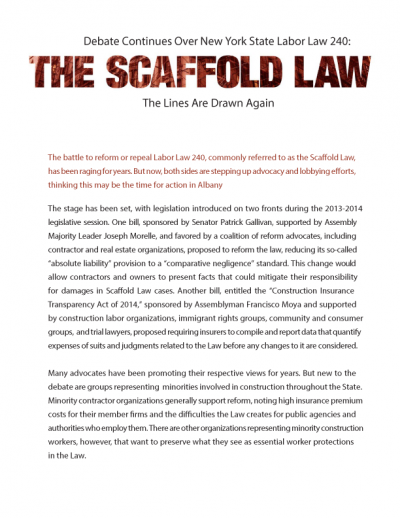
THE SCAFFOLD LAW
Page 3
WHAT IS THE CASE FOR REFORM
OF THE SCAFFOLD LAW?
Contractor and real estate organizations contend that absolute liability is the fatal flaw in the application of the Scaffold Law and that the situation is now a crisis not just about higher insurance premiums, but also about the availability of insurance/liability coverage for real estate owners, construction companies, and public agencies working in the State. This crisis - exacerbated by higher jury awards and broadened judicial application of the Law - now threatens, they maintain, the size of public capital programs and costs, or will cost, tens of thousands of construction jobs. Consequently, according to Michael Elmendorf, President and CEO of the Associated General Contractors of New York State, there is and will be "less money for jobs and more for insurance."
When asked what is different now that might improve the chances for successful Scaffold Law reform, Mr. Elmendorf said, "This used to be a crisis of cost. Now, it has gotten so bad that it is a crisis of availability." He explained that "there are less than a handful of carriers" willing to take on the risk of insuring construction sites in the State since "they can't control their exposure." On the outlook for reform, he asserted, "The law is going to change soon, either on the merits or because of the near impossibility of insuring [projects]."
According to Joseph T. Gunn, Regional Partner, Willis of New York, the Scaffold Law is "the only liability law on the books in New York that does not allow contributory facts to be considered in cases." Compounding this inability to defend against injury claims, he said, is the broader judicial interpretation of injuries that qualify for protection under the Law. To this point, reform advocates contend, no other state in the country has a similar law that is as broadly applied or as costly as New York's Scaffold Law.
Stephan Upshaw, Vice President of Risk Management for Equity Residential, a national owner/developer, agrees that the situation is clearly worsening, judging by the comparative costs of insurance coverage on development projects in the City versus the rest of the country, as well as within the City in years past. He said Equity's most recent development, at 170 Amsterdam Avenue, cost several million dollars more for insurance coverage than the company's comparable project two years earlier at Tenth Avenue and 23rd Street. Equity was still able to make the newer project work, but he acknowledged that when other developers feel this kind of squeeze, building design and amenities could suffer as a consequence. What's more, he believes that smaller projects, under $100 million, "projects that could turn a neighborhood around, won't get done" because of high insurance costs. Mr. Upshaw said similar projects the firm has completed in New Jersey and elsewhere include far less for insurance costs.
Notably, organizations joining forces with the usual reform advocates now include many representing minority contractors and subcontractors who believe capital programs that employ them in greater numbers are, at a minimum, being scaled back by the pressure of mounting insurance costs. Explaining her organization's involvement, Elizabeth Velez, President of the Velez Organization and Chairwoman of the Latino Builders Council, said, "Any system which includes a provision of absolute liability where a defendant has absolutely no say in the matter is patently unfair. . . ." She added that the insurance premiums for her company, and others like hers, are expected to double this year, after nearly doubling last year as well.



